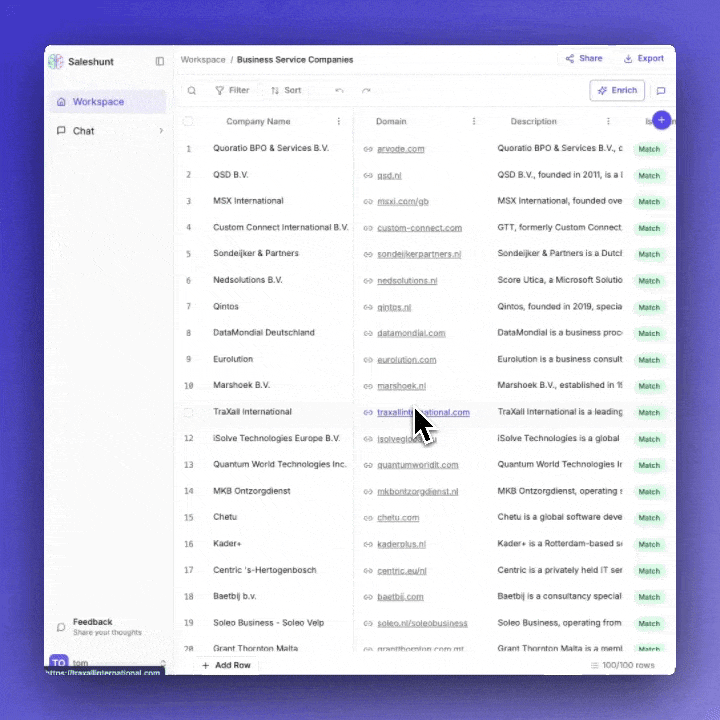Columns
Ask powerful questions at scale by turning columns into research agents

In Saleshunt, every column isn’t just a place to store data — it’s a question you’re asking at scale. Instead of manually searching and copying information, you ask your question once, and AI agents find the answer for every company in your list.
Each column runs as a scalable research task, uncovering insights like “Has raised funding?” or “What AI tools does this company use?” — giving you a granular, always-updating view of your market.
How Columns Work
Adding a column is like assigning an analyst to every row. You write the question once, and Saleshunt handles the rest — running hundreds of research agents in parallel to find the answers.
Once created, simply select the cells you want to enrich and hit Enrich. The AI reads your prompt, searches public data like their websites, LinkedIn pages, and recent articles, and writes a custom answer for each row.
Adding a Column

- Name your column — Enter a short, specific question (e.g., "Mentions AI")
- Set column type — Choose Text, Date, Number, or URL
- Review the prompt — We auto-generate an AI-friendly version. This is where you apply your domain expertise—tell the AI exactly what to look for and where, just like briefing a research analyst
- Add dependencies (optional) — Reference other columns for context
When you type a column name, Saleshunt suggests a detailed research prompt that you can refine before running. Click the expand icon to open a larger editor for advanced prompt editing.
The prompt is your superpower — You're the domain expert who knows what signals matter and where to find them. Saleshunt provides the scalable automation to execute your expertise across hundreds of companies at once.
Learn more: Column Dependencies guide
Tip: Test on a few rows first to check output quality before enriching at scale. This helps fine-tune your question and control costs.
Column Types & Output Control
Choose from four column types: Text (default), Date, Number, or URL. Set the type when creating a column or change it anytime via the three dots menu in the column header.
How you frame your question determines the output format:
- Ask "Does this company sell to enterprise?" for a yes/no answer
- Request "What does their website say about AI?" for detailed insights
- Use "Classify as: platform, integrator, or vendor" for categorization
- Try "Rate ICP fit from 1-5" for scoring
The AI adapts to your prompt style and formats responses accordingly.
What We Can and Can't (yet) Find
Every column you create spins up a team of AI agents that search the web, tap into third-party sources, and extract structured insights at scale. While there’s a lot they can do, there are still some limits.
Public data from company websites, press releases, directories, and databases
High-accuracy contact details from public sources, enriched with third-party providers
Financial data from public reports and partner integrations (e.g. revenue, funding, EBITDA)
Some gated information behind logins/paywalls via third-party integrations and scraping tools
Trend signals based on market activity and company behavior
Data that simply doesn't exist online or hasn't been published yet
Private or personal contact info not intended for public use
Confidential financial records like private P&Ls or internal valuations
Content locked behind enterprise-grade authentication or paywalls without extractable text
Guaranteed predictions about the future (e.g. "Will this company raise soon?")
Saleshunt extracts and structures what's already publicly accessible. If something's not showing up, try rephrasing your question or verifying the data exists somewhere online.
From Question to Insights
Columns are your superpower for researching at scale. What used to take hours of Googling, now takes seconds — across hundreds of companies. Just ask your question once, and Saleshunt finds the answers.